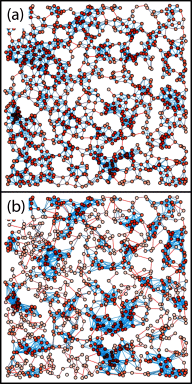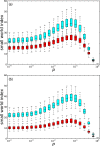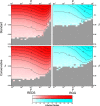Infection dynamics on spatial small-world network models
- PMID: 29347688
- PMCID: PMC7217528
- DOI: 10.1103/PhysRevE.96.052316
Infection dynamics on spatial small-world network models
Abstract
The study of complex networks, and in particular of social networks, has mostly concentrated on relational networks, abstracting the distance between nodes. Spatial networks are, however, extremely relevant in our daily lives, and a large body of research exists to show that the distances between nodes greatly influence the cost and probability of establishing and maintaining a link. A random geometric graph (RGG) is the main type of synthetic network model used to mimic the statistical properties and behavior of many social networks. We propose a model, called REDS, that extends energy-constrained RGGs to account for the synergic effect of sharing the cost of a link with our neighbors, as is observed in real relational networks. We apply both the standard Watts-Strogatz rewiring procedure and another method that conserves the degree distribution of the network. The second technique was developed to eliminate unwanted forms of spatial correlation between the degree of nodes that are affected by rewiring, limiting the effect on other properties such as clustering and assortativity. We analyze both the statistical properties of these two network types and their epidemiological behavior when used as a substrate for a standard susceptible-infected-susceptible compartmental model. We consider and discuss the differences in properties and behavior between RGGs and REDS as rewiring increases and as infection parameters are changed. We report considerable differences both between the network types and, in the case of REDS, between the two rewiring schemes. We conclude that REDS represent, with the application of these rewiring mechanisms, extremely useful and interesting tools in the study of social and epidemiological phenomena in synthetic complex networks.
Figures





Similar articles
-
Structural trade-offs can predict rewiring in shrinking social networks.J Anim Ecol. 2021 Jan;90(1):120-130. doi: 10.1111/1365-2656.13140. Epub 2019 Dec 2. J Anim Ecol. 2021. PMID: 31691962
-
Impact of constrained rewiring on network structure and node dynamics.Phys Rev E Stat Nonlin Soft Matter Phys. 2014 Nov;90(5-1):052806. doi: 10.1103/PhysRevE.90.052806. Epub 2014 Nov 11. Phys Rev E Stat Nonlin Soft Matter Phys. 2014. PMID: 25493833
-
Epidemic spreading in random rectangular networks.Phys Rev E. 2016 Nov;94(5-1):052316. doi: 10.1103/PhysRevE.94.052316. Epub 2016 Nov 28. Phys Rev E. 2016. PMID: 27967075 Free PMC article.
-
Rewiring dynamical networks with prescribed degree distribution for enhancing synchronizability.Chaos. 2010 Dec;20(4):043119. doi: 10.1063/1.3515170. Chaos. 2010. PMID: 21198089
-
Network rewiring dynamics with convergence towards a star network.Proc Math Phys Eng Sci. 2016 Oct;472(2194):20160236. doi: 10.1098/rspa.2016.0236. Proc Math Phys Eng Sci. 2016. PMID: 27843396 Free PMC article.
Cited by
-
Assortative mixing in spatially-extended networks.Sci Rep. 2018 Sep 14;8(1):13825. doi: 10.1038/s41598-018-32160-4. Sci Rep. 2018. PMID: 30218078 Free PMC article.
References
-
- M. Newman, Networks: An Introduction (Oxford University, Oxford, 2010).
-
- A. Barrat, M. Barthelemy, and A. Vespignani, Dynamical Processes on Complex Networks (Cambridge University, Washington, DC, 2008).
-
- M. Barthélemy, Phys. Rep. 499, 1 (2011).PRPLCM10.1016/j.physrep.2010.11.002 - DOI
-
- D. Mok, B. Wellman, and J. Carrasco, Urban Studies 47, 2747 (2010).10.1177/0042098010377363 - DOI
-
- L. M. Aiello, A. Barrat, C. Cattuto, G. Ruffo, and R. Schifanella, in IEEE Second International Conference on Social Computing, 2010 (IEEE, Cambridge, 2010), pp. 249–256.
LinkOut - more resources
Full Text Sources
Other Literature Sources
